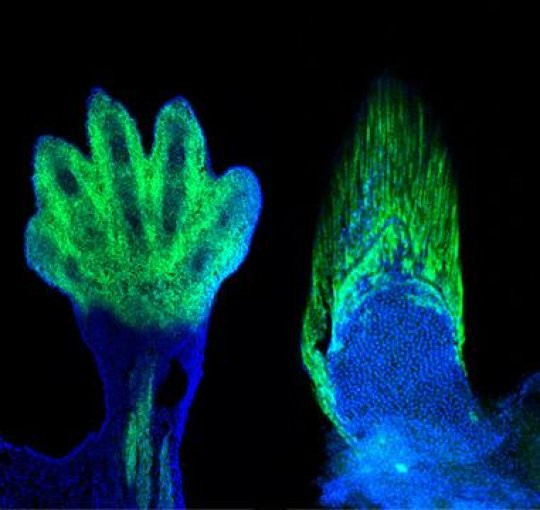Breeding of 'mutant fish' offers clues on how fins became fingers
For years, scientists have thought that fin rays were unrelated to digits in four-legged animals.

Over millions of years, the descendants of fish replaced their fins for limbs in one of the great evolutionary transformations, as they made their way from the sea onto land. Now scientists have a clearer understanding of exactly how this anatomical metamorphosis came about.
New research, conducted by scientists from the University of Chicago and published in the journal Nature, suggests that the same cells which cause fish to develop fin rays, are also important in the formation of limbs and digits in four-legged animals.
Using advanced new gene-editing techniques and technology that can track developing cells, the researchers were able to detail how the small flexible bones found at the end of fins are related to fingers and toes.
"When I first saw these results you could have knocked me over with a feather," said the lead author of the study, Neil Shubin, a professor of organismal biology and anatomy at the University of Chicago. Shubin is a leading expert on the evolutionary transition from fins to limbs.
"For years, scientists have thought that fin rays were completely unrelated to fingers and toes, utterly dissimilar because one kind of bone is initially formed out of cartilage and the other is formed in simple connective tissue", he said. "Our results change that whole idea. We now have a lot of things to rethink."
In their attempts to decode exactly how the process works, the team selectively bred mutant versions of a tropical freshwater fish – called a zebrafish - which had important genes linked to limb-building removed using a novel gene-editing technique known as CRISPR/Cas.
Meanwhile, a former graduate student of Shubin's, Andrew Gehrke was working on cell-labelling techniques that could identify when and where specific embryonic cells migrated as the animals grew and developed.
"It was one of those eureka moments," Gehrke said. "We found that the cells that mark the wrists and fingers of mice and people were exclusively in the fin rays of fish."
The focus of the team's work was on Hox genes which are responsible for directing how an embryo grows from the head down to the tail, and from the shoulders to the fingertips. The genes are also important for limb development.
The scientists studied the development of cells, from just after fertilization until they formed part of an adult fin. Previous studies in mice have shown that when Hox genes are deleted, specifically ones linked to wrists and digits, those structures do not develop. When the same genes were deleted in the zebrafish, the fin rays were significantly reduced in size.
"What matters is not what happens when you knock out a single gene but when you do it in combination," Tetsuya Nakamura, a postdoctoral researcher in Shubin's lab explained. "That's where the magic happens."
In addition to these techniques, the team also used a CT scanner to reveal the minute structures within the adult zebrafish fin which can be invisible, even to most traditional microscopes. The CT scans showed that the fish which were lacking certain genes lost fin rays, however, the small bones made of cartilage actually increased in number.
The scientists hypothesise that cells in the mutant fish stopped migrating from the base of the fin to their usual position near the tip, meaning there were fewer cells available to produce fin rays but more to make the small cartilage bones.
"It really took the combination of labelling and gene-deletion to convince us that this cellular relationship between fins and limbs was real," Gehrke said.
Future studies will focus on trying to find further fossil intermediates which are caught in the middle of the evolutionary path between fish and limbs, much like the Tiktaalik, discovered by Shubin and his colleagues in 2006. The creature is one of the best examples of a link between primitive fish and four-legged animals. The researchers are also planning to study why Hox genes form such differing structures in different animals despite sharing similar characteristics across species.
© Copyright IBTimes 2025. All rights reserved.





















